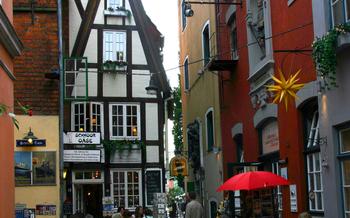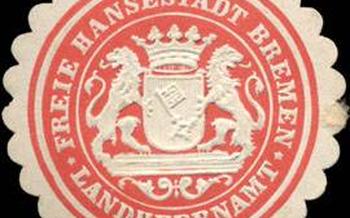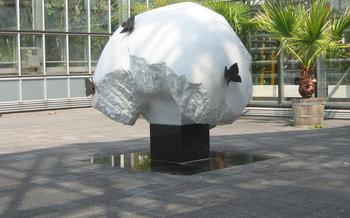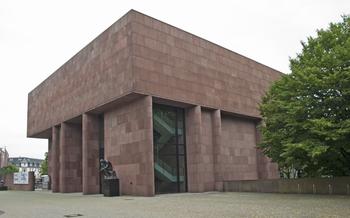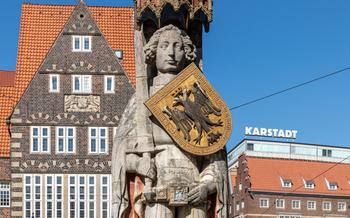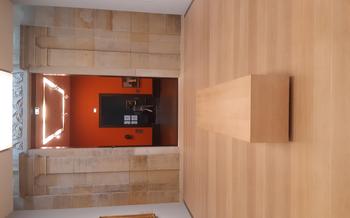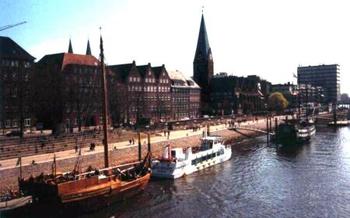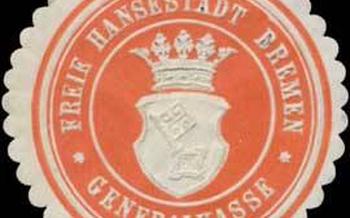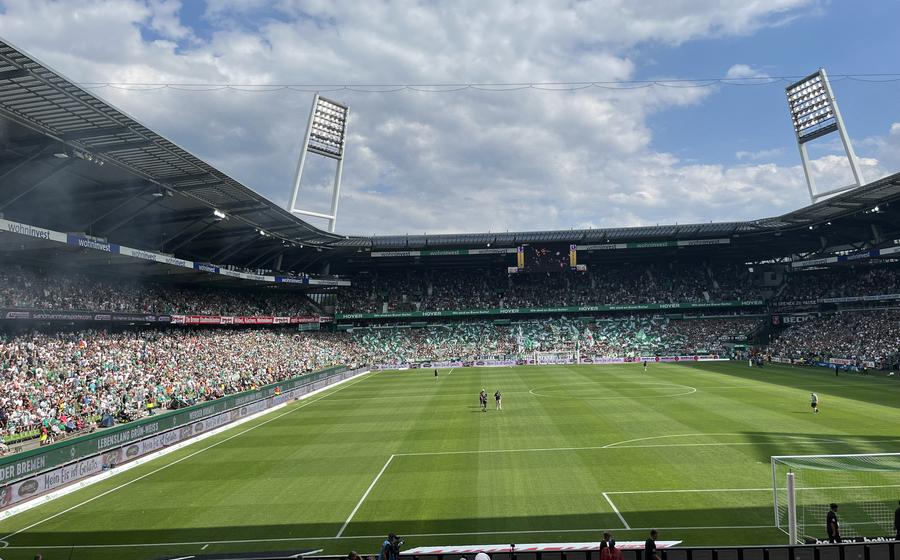
Gröpelingen Sculpture Project
- Participating Artists
- Interactive Experience
- Unique Sculptures
- Thematic Elements:
- Materials and Techniques
- Walking Tour
- Local Perspectives
- Cultural Significance:
- Artistic Legacy
- Educational Value
- Accessibility:
- Future Plans:
- Insider Tip:
Participating Artists
The Gröpelingen Sculpture Project brought together a diverse group of established and emerging artists from across Germany and beyond. Each artist contributed their unique style and perspective, resulting in a rich tapestry of artistic expression.
Among the notable participants was Ulrich Rückriem, known for his minimalist sculptures that explore the relationship between form and space. His work, "Ohne Titel" (Untitled), is a striking example of his signature style, featuring a simple yet powerful arrangement of granite blocks.
Another prominent artist was Magdalena Abakanowicz, a Polish sculptor whose work often addresses themes of the human body and the collective. Her sculpture, "Crowd III," is a haunting and evocative representation of a group of figures huddled together, conveying a sense of vulnerability and anonymity.
Thomas Schütte was also a key contributor to the project. His whimsical and often humorous sculptures often engage with everyday objects and situations. His work, "Frau mit Hut" (Woman with Hat), depicts a woman wearing a large, colorful hat, adding a playful and surreal element to the urban landscape.
These are just a few examples of the talented artists who participated in the Gröpelingen Sculpture Project. Their diverse styles and approaches contributed to the project's richness and complexity, creating a unique and memorable experience for visitors.
Interactive Experience
The Gröpelingen Sculpture Project is not just a collection of static artworks; it's an interactive experience that encourages public engagement and appreciation for art. Many sculptures invite viewers to touch, climb, or interact with them in some way, fostering a sense of connection and ownership.
This interactive element adds a playful and engaging dimension to the project, making it accessible and enjoyable for visitors of all ages. By blurring the boundaries between artwork and viewer, the sculptures create a unique and memorable experience that goes beyond traditional museum visits.
Unique Sculptures
Among the many captivating sculptures that grace the Gröpelingen district, a few stand out for their remarkable visual impact and intriguing stories. One such piece is "The Musicians" by German artist Jürgen Knubben. This vibrant steel sculpture depicts a group of musicians playing their instruments, capturing the essence of Bremen's rich musical heritage. The sculpture's dynamic composition and colorful accents make it a popular photo spot for visitors.
Another notable work is "The Flying Fish" by Chinese artist Li Xiangqun. This whimsical sculpture features a giant fish seemingly leaping out of the water, symbolizing the district's proximity to the Weser River. Made from stainless steel, the sculpture's shimmering surface reflects the changing light, creating a mesmerizing effect.
Equally striking is "The Tree of Life" by Colombian artist Fernando Botero. Carved from a single block of Carrara marble, this monumental sculpture depicts a towering tree with intertwined branches and human figures. Botero's signature style, characterized by exaggerated forms and voluptuous figures, adds a touch of playful surrealism to the artwork.
These sculptures, along with many others, contribute to the unique identity of the Gröpelingen Sculpture Project, making it a must-see destination for art enthusiasts and visitors seeking a truly immersive cultural experience.
Thematic Elements:
The Gröpelingen Sculpture Project features a diverse range of sculptures that explore various themes and motifs. One recurring theme is the connection between humans and nature, expressed through sculptures that depict figures interacting with plants, animals, or natural elements. Another prevalent theme is the history and culture of Bremen, represented in sculptures that reference local legends, maritime traditions, or architectural landmarks. Some sculptures also explore abstract concepts such as movement, balance, or the passage of time, inviting viewers to contemplate their own interpretations.
The project's sculptures collectively reflect the spirit of Bremen, a city known for its rich history, cultural diversity, and vibrant arts scene. Gröpelingen, in particular, is a district that has undergone significant transformation over the years, from a working-class neighborhood to a multicultural hub. The sculptures capture this evolution, celebrating the district's unique identity and its contributions to the city's cultural fabric.
Materials and Techniques
The artists involved in the Gröpelingen Sculpture Project employed a diverse range of materials and techniques to bring their creative visions to life. Traditional materials such as bronze, stone, and wood were used alongside more unconventional choices like recycled objects, textiles, and even light. The resulting sculptures showcase a variety of textures, colors, and forms, creating a visually dynamic and engaging experience for visitors.
Some of the notable techniques used in the project include:
-
Welding: Used to create intricate metal sculptures, such as the "Birdhouse" by Ulrich Rückriem, which features a delicate framework of welded steel rods.
-
Casting: Employed to produce bronze sculptures, such as the life-size "Standing Woman" by Waldemar Otto, which captures the essence of human form with remarkable precision.
-
Carving: Used to shape sculptures from solid blocks of stone or wood, such as the abstract "Totem" by Karl Hartung, which displays the artist's mastery of form and texture.
-
Assemblage: Involving the combination of found objects and discarded materials to create unique sculptures, such as the "Chair with Wheels" by Dieter Roth, which is constructed from a repurposed chair and bicycle wheels.
-
Light Installations: Used to create dynamic and immersive artworks, such as the "Lighthouse" by Ólafur Elíasson, which projects a mesmerizing beam of light into the night sky.
The variety of materials and techniques employed in the Gröpelingen Sculpture Project reflects the diverse artistic approaches and styles of the participating artists. From traditional craftsmanship to experimental and innovative techniques, the sculptures showcase the richness and creativity of contemporary public art.
Walking Tour
To fully appreciate the Gröpelingen Sculpture Project, embark on a leisurely walking tour that takes you past each artwork. Begin your journey at the Gröpelingen Market Square, where you'll find the striking "Torso" sculpture by German artist Waldemar Otto. From there, follow a path that leads you through the district's streets and parks, encountering sculptures that blend seamlessly into the urban landscape.
The total walking distance is approximately 3 kilometers, and the tour can be completed in about 1-2 hours, depending on your pace and the time you spend admiring each artwork. Along the way, you'll encounter sculptures that range from abstract to figurative, each with its own unique story to tell.
To enhance your experience, consider picking up a map or guidebook from the Gröpelingen Tourist Information Center. These resources provide detailed information about each sculpture, including its title, artist, and year of creation. They also suggest walking routes that cater to different interests and time constraints.
As you navigate the district, keep an eye out for sculptures that interact with their surroundings. Some sculptures incorporate elements of the natural environment, such as trees or rocks, while others play with light and shadow to create dynamic effects. Don't hesitate to touch and interact with the sculptures where permitted; many of them are designed to be experienced in a hands-on way.
Local Perspectives
The Gröpelingen Sculpture Project has had a profound impact on the local community. Residents of Gröpelingen have embraced the project and see it as a source of pride and identity. They take ownership of the sculptures, often referring to them as "our sculptures" or "the sculptures in our neighborhood."
Many local residents have personal stories and anecdotes related to the sculptures. Some recall the excitement of watching the artists work and seeing the sculptures take shape. Others share memories of playing around the sculptures as children or using them as landmarks for neighborhood adventures.
One local resident, Frau Schmidt, recalls how the sculptures brought her family closer together. "My husband and I used to take our children for walks around the neighborhood to see the sculptures," she says. "It was a great way to spend time together and talk about art and creativity."
The sculptures have also become a focal point for community events and gatherings. Local schools and organizations often use the sculptures as a backdrop for art exhibitions, concerts, and other cultural events.
The Gröpelingen Sculpture Project has not only transformed the physical landscape of the neighborhood but has also created a sense of community and belonging among its residents. The sculptures are a reminder of the power of art to bring people together and create a more vibrant and livable city.
Cultural Significance:
The Gröpelingen Sculpture Project has been a significant contributor to Bremen's reputation as a vibrant arts and culture hub. The city has a long history of supporting public art, and this project has played a vital role in further enhancing its status as a cultural destination. The sculptures have become iconic landmarks in the Gröpelingen district, attracting visitors from all over the world. The project has also spurred the development of other cultural initiatives in the area, such as art galleries, theaters, and music venues.
Overall, the Gröpelingen Sculpture Project has left an indelible mark on Bremen's cultural landscape, transforming it into a city where art is celebrated, appreciated, and accessible to all. It has demonstrated the power of public art to revitalize communities, inspire creativity, and foster a sense of pride and belonging among residents.
Artistic Legacy
The Gröpelingen Sculpture Project has had a profound impact on the field of public art, serving as a model for similar initiatives in other cities and countries. Its success in fostering collaboration between artists and communities has inspired projects that prioritize local engagement and artistic expression in urban planning. The project's emphasis on accessibility and educational programming has also set a precedent for public art projects that aim to reach a diverse audience and promote art appreciation.
The Gröpelingen Sculpture Project's legacy extends beyond its physical presence in Bremen. It has contributed to the city's reputation as a vibrant arts hub, attracting visitors and artists from around the world. The project's innovative approach to public art has been recognized and celebrated by art critics and urban planners, earning Bremen a place among the leading cities for contemporary public art.
Educational Value
The Gröpelingen Sculpture Project is not just a collection of artworks; it is also a valuable educational resource. Guided tours are available for groups of all ages, providing insights into the history, artistic vision, and creative process behind the sculptures. Workshops are also organized, allowing participants to explore different art forms, develop their creativity, and gain a deeper appreciation for public art.
The sculptures themselves serve as a powerful teaching tool for art appreciation and urban planning. They demonstrate the diverse range of artistic styles and techniques, encouraging viewers to think critically about the role of art in public spaces. The project also highlights the importance of collaboration between artists and the community, showcasing how art can be used to transform and revitalize urban environments.
Accessibility:
The Gröpelingen Sculpture Project is committed to ensuring that everyone can enjoy and appreciate the sculptures. The project's accessibility features make it a welcoming and inclusive space for visitors of all abilities. Wheelchair-accessible routes have been carefully planned, allowing visitors with mobility challenges to navigate the district and explore the sculptures without barriers. Additionally, there are designated parking spaces for visitors with disabilities, providing convenient access to the project. For those who need assistance, the project's website offers detailed information on accessible routes and provides contact information for assistance. The project's commitment to accessibility ensures that everyone can experience the beauty and inspiration of the Gröpelingen Sculpture Project, regardless of their physical abilities.
Future Plans:
The Gröpelingen Sculpture Project is a dynamic and evolving initiative, with ongoing plans to maintain and expand its collection. Regular maintenance and restoration efforts ensure that the sculptures remain in pristine condition for future generations to appreciate. Additionally, the project is open to new submissions from artists, providing opportunities for emerging talents to showcase their work alongside established names.
Future plans also include the organization of temporary exhibitions and events related to the sculptures. These events aim to engage the community and foster a deeper appreciation for public art. Workshops and educational programs are also in the pipeline, providing opportunities for visitors to learn more about the creative process and the significance of the Gröpelingen Sculpture Project.
By embracing innovation and collaboration, the project continues to grow and adapt to the changing landscape of contemporary art. It remains a vibrant and evolving space, inviting visitors to experience the transformative power of public art and explore the rich cultural heritage of Bremen.
Insider Tip:
For a delightful break during your sculpture tour, I highly recommend Café Grün, just a short stroll from the project. This charming café offers a cozy ambiance, a tempting selection of homemade cakes, and a refreshing menu of drinks. As you savor your treat, take a moment to reflect on the Gröpelingen Sculpture Project and its unique blend of art, history, and community.
Insider tip: If you happen to visit on a Saturday morning, be sure to check out the bustling Gröpelingen Market, where you can browse local produce, artisanal crafts, and delicious street food. It's a fantastic opportunity to immerse yourself in the vibrant atmosphere of this diverse neighborhood.
